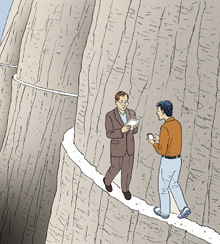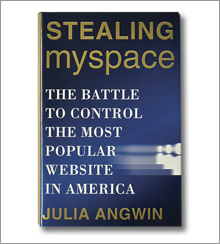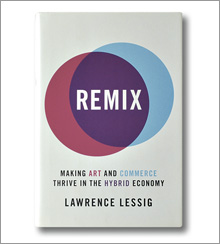Best Business Books 2009: Technology
Disruption 2.0
Julia Angwin
Stealing MySpace: The Battle to Control the Most Popular Website in America
(Random House, 2009)
Lawrence Lessig
Remix: Making Art and Commerce Thrive in the Hybrid Economy
(Penguin, 2008)
Scott Rosenberg
Say Everything: How Blogging Began, What It’s Becoming, and Why It Matters
(Crown, 2009)
In March 2007, at a lunch with MySpace.com founders Tom Anderson and Chris DeWolfe, I personally delivered what I thought would be some troubling news to them. MySpace had just lost the United Nations School in New York City. My son, who was then a junior at that high school, had been part of a cohort that spent a huge amount of time on the social network. But recently, the entire junior and senior class had engaged in a mass defection to Facebook. What’s more, I had collected anecdotal information that this was happening all over the country.
I thought I knew what the MySpacers would reply. They first would acknowledge the trend and assure me they were on top of the situation. Then they would outline the myriad ways they were improving their site to make it more compelling for people like my son and his friends. But to my surprise, they shrugged off the migration, sniffing that it was an isolated phenomenon among privileged East Coast schools, and changed the subject to movie tie-ins with the MySpace parent company, Rupert Murdoch’s News Corporation. They were also eager to discuss their plans to start a record label. No matter how hard I tried, they would not engage in a discussion of the competition between MySpace and other social networking sites.
I was baffled. Two years later, Facebook — growing at a breakneck pace — passed the flatlining MySpace in number of users. And I was still baffled by Anderson and DeWolfe’s continued insouciance. But Julia Angwin’s relentlessly researched and compellingly rendered Stealing MySpace: The Battle to Control the Most Popular Website in America explains everything. The founders of MySpace had unwittingly put their company in jeopardy because they, like a surprising number of other technology pioneers, did not understand the nature of what they had created.
Stealing MySpace, along with the other two books that stand out in the business and technology field this year, would seem at first glance to grapple with a particular aspect of the digital revolution: the empowering effect of technologies that allow people to communicate, connect, and express themselves on a global scale via the Internet. This effect alters the relationship between companies and customers, which, in turn, lays waste to traditional business models, while giving rise to new ones.
The direction of technology itself is rather predictable. We know that it insistently drives forward, powered by the rocket fuel of Moore’s Law and a seemingly bottomless reservoir of innovation and brainpower, most often generated by fuzzy-cheeked geeks wearing sneakers. But those people actually running businesses — not just the enterprises that introduce disruptive elements, but all of the enterprises subsequently affected, too — must navigate new minefields. How well they do this depends not just on wizardry and gadgetry, but also on more elusive factors like personality, culture, and a knack for knowing what to do when the lawyers come calling.
One might assume that a book about MySpace, which seems to deserve the “most popular Website” description in the subtitle (more than 70 million users by April 2008), would be a chronicle of far-seeing visionaries who first identified, then successfully harnessed, the need that young people had to organize their social networks online. That’s not the case. Nor is Stealing MySpace a deep analysis of what the company means to the millions of people who create messy pages, swap songs, and intemperately post party pictures on its site. Angwin is less concerned with cultural effects than she is with spinning an old-fashioned investigative boardroom drama.
MySpace’s DNA did not spring from the gene pool that yielded great Internet companies like Amazon, eBay, and Google, but from a fetid digital backwater called eUniverse, based in an industrial park near the Los Angeles airport. The idea sprang from two “cubicle-dwelling marketing executives with no technical prowess or revolutionary ideas,” Angwin writes. As a teenager, Anderson had flirted with the dark-hat hacker underground; he was mentored by Bill Landreth, a well-known malefactor who parlayed a criminal record into a book contract with Microsoft Press. Later, he got involved in a website focusing on Asian pornography. DeWolfe was a frat-boy finance major who took a marketing job during the first dot-com boom. His activities at eUniverse involved creating e-mail spam and spyware; his big success was getting people to download a patriotic cursor (to show support for Operation Desert Storm) that secretly loaded software to snoop on their online activities. EUniverse, writes Angwin, was “the trailer park of the Internet.”
When DeWolfe launched MySpace as an eUniverse property in 2003, it seemed like yet another exercise in bottom-feeding: It was a bald attempt to clone what was then the Net’s hottest newcomer, a social networking site called Friendster. Despite massive buzz and investments from top venture-capital firms, Friendster flamed out while MySpace thrived.
How did two SoCal hustlers beat out a Silicon Valley first mover? One factor was MySpace’s malleability — of all the social networks, MySpace has been the one to allow users the most latitude. This tapped into the teenage urge to personalize a corner of the Internet, even though it wound up making a user’s space the digital equivalent of a disheveled dorm room. Angwin reveals that this was not a conscious management decision, but sloppy programming that enabled users to hack their own pages. And whereas Friendster was built to reflect users’ real identities and help people connect with others in the spirit of an actual social circle, MySpace wasn’t nearly as picky. People could use fake identities or try out alternative personalities. Emerging rock bands or wannabe celebrities were welcome to solicit and link to massive numbers of “friends.” A soft-porn model named Tila Tequila garnered 1.7 million MySpace friends.
Angwin deftly describes how as MySpace grew, DeWolfe and Anderson became more committed to its mission. But they found themselves fighting the fast-buck mentality of its parent company. MySpace had become eUniverse’s most valuable property. The tale takes on Shakespearean tones when eUniverse’s CEO, a golden-tongued businessman named Richard Rosenblatt, enters negotiations to sell the company to Rupert Murdoch’s News Corporation without the knowledge of DeWolfe and Anderson. Another suitor was Viacom, and followers of the long-running war of media behemoths will savor the competition between Murdoch and archrival Sumner Redstone, CEO of Viacom. (Bottom line: Murdoch’s trust in his executives allowed News Corporation to move nimbly, while the paranoid Redstone fumbled the deal by second-guessing his underlings — and then blamed them for losing the prize.)
True to Rosenblatt’s promise, MySpace got Rupert Murdoch on the cover of Wired. And a US$900 million ad deal with Google seemed to make Murdoch’s $580 million purchase price a bargain. But DeWolfe and Anderson — who were shut out of the Google negotiations — still found themselves struggling to control their creation, this time squabbling with Murdoch’s minions. All this was a distraction from the surprisingly strong challenge from Facebook — the threat that MySpace’s founders tried to shrug off during our lunch. (Angwin recounts something else DeWolfe and Anderson didn’t mention during our meal — that MySpace tried to buy Facebook. Twice. Both times, the asking price was way too high for MySpace’s taste.)
The speed of MySpace’s relative decline has apparently blindsided even the gimlet-eyed Angwin. In her epilogue, she writes, “MySpace remains the dominant social networking website.… Facebook is just half the size.” But those were last year’s numbers. In May 2009, MySpace’s problems became sufficiently dire for Murdoch to fire DeWolfe and shuffle Anderson off to a quiet office. The new CEO is Owen Van Natta, formerly an executive at Facebook.
There is a bigger picture behind the phenomenon that drew millions to MySpace: the shift that suddenly opened a new channel of communication, part personal and part broadcasting. Because it is as easy for friends to share copyrighted digital files as it is to tweet their activities, the Net is also a disruptive (to say the least) distribution system. Cheap, or free, software tools allow people to add their own creative spin to existing books, movies, and songs — though the activity is currently illegal. But when a technological reset dramatically alters the landscape, shouldn’t legal boundaries be altered as well? And if so, which ones? And how?
These are complicated questions, and no one has deconstructed them more vividly than law professor Lawrence Lessig. (See “Lawrence Lessig: The Thought Leader Interview,” by Lawrence M. Fisher, s+b, Second Quarter 2002.) Over the past decade, Lessig has been writing what may now be seen as a multivolume work on how the Web interacts — and often clashes — with the law. (His pioneering role in the field has earned him the sobriquet “the Elvis of cyberlaw.”) Taken as a whole, Lessig’s body of work is sort of a digital War and Peace, a mix of gleeful optimism at the new creative opportunities the technology provides and grim hand-wringing at how entrenched forces can stifle those prospects with restrictive regulations and software. The latest tome is Remix: Making Art and Commerce Thrive in the Hybrid Economy.
Make no mistake, Lessig is an advocate. He tilts his lance at the entrenched forces that have fortified and extended the laws of copyright. The Recording Industry Association of America probably considers him a bigger threat than peer-to-peer file-sharing programs like LimeWire. Lessig has even abandoned his armchair to found an organization, Creative Commons, that allows artists to register their work in a way that circumvents the restrictive default copyright status, allowing more freedom to those who would share the works or include portions of them in their own creations. But he also bristles at attempts to make him into a radical who wants to eliminate copyright entirely.
In Remix, Lessig draws a sweeping picture of the rise, fall, and budding revival of participatory culture. He starts with the 19th century; before radio and phonographs, people actually made their own music! (John Philip Sousa, Lessig tells us, argued for copyright protection, but also worried that the advent of “infernal machines” would mean the end of the amateur music maker.) Lessig describes that participatory process as “read write” (RW) culture. During the 20th century, however, popular media such as radio, vinyl recording disks, and movies generated an overwhelming bias toward “read only” (RO) culture, where highly commercialized information, art, and entertainment was delivered to passive listeners and viewers who had little ability — and less inclination — to create their own work.
In the 21st century, the era of digital files and the Internet, it’s much easier for amateurs to tweak existing works, mix them into new creations, or hatch new work. And for the first time, instant global distribution is accessible to all. (With a $200 Flip video camera and YouTube, millions have the power that only a few decades ago was reserved for a very few broadcasters.) As you would expect, we’re seeing a triumphant return to RW culture, and Lessig trots out a number of examples, including a Pittsburgh medical technician who mines hundreds of songs to create avant-garde remixes (called mash-ups) and communities making Star Wars sequels with Lego blocks.
Unfortunately, says Lessig, our current laws regard the creation of such works as a criminal act. The situation is not only repressive, it’s ludicrous, according to Lessig, who argues, “We can’t make our kids passive in the way we were toward the culture around us. We can only make them ‘pirates.’” Even when the law doesn’t prohibit remixing (such as under fair use provisions), some copyright holders have installed digital locks on their works to deny even legal reuse of the material.
Having established these points in the first half of Remix, Lessig tries something more ambitious in the second part of the book: laying the groundwork for an entirely new copyright system through which artists and businesses might make money in an era of thriving, and legal, RW culture. Although not necessarily convincing, his arguments are fascinating.
Lessig delineates two current economies on the Internet: a traditional commercial one in which the dominant form of exchange is money, and a “sharing economy,” in which labor and goods are traded for love, altruism, patriotism, the fun of participation...anything, it seems, but money. Amazon belongs to the first economy, and Wikipedia is a prime example of the second. Lessig envisions the emergence of “an increasingly important third economy: one that builds upon both the sharing and commercial economies, one that adds value to each. This third type — the hybrid — will dominate the architecture for commerce on the Web…. The hybrid is either a commercial entity that aims to leverage value from a sharing economy, or it is a sharing economy that builds a commercial entity to better support its sharing aims. Either way, the hybrid links two simpler, or purer, economies, and produces something from the link.”
In other words, the Third Way is definitely for-profit but not rapaciously so, and such businesses are synced to the sharing spirit of the Web. It sounds terrific, but the examples Lessig gives aren’t exactly overwhelming. There’s Red Hat, the company promoting the open source Linux (struggling in recent years). He also cites Flickr, a photo-sharing site (now owned by Yahoo) that takes in revenues from premium memberships. He talks about Craigslist, a service that was firmly planted in the sharing economy but is still struggling to figure out how far it wants to venture into the commercial realm. (Oddly, Lessig doesn’t dwell on the examples of social networking sites like Facebook or MySpace, which appear to fit his hybrid prototype, with their for-profit exploitation of user content.)
Lessig returns to firmer ground in his conclusions, where once again he urges a rethinking of copyright laws. His closing argument, while spirited, has an elegiac tone. After four books attacking copyright laws, Lessig is on to his next crusade — fighting the influence of campaign money on legislators. Throughout the copyright controversy, Lessig’s arguments have ultimately rested on common sense and logic. As far as legislators are concerned, both of these are almost always trumped by special interest money. Case in point: a copyright regimen that has criminalized an entire generation.
One of the most prominent examples of 21st-century RW culture owes less to remixing than to simple expression. That would be blogging. This doesn’t surprise Scott Rosenberg, a former newspaper writer turned online journalist and blogger. “Communication,” he writes in Say Everything: How Blogging Began, What It’s Becoming, and Why It Matters, “was not some bell or whistle. It was the whole point of the Web, the defining trait of the new medium — like motion in movies, or sound in radio, or narrow columns of text in newspapers.” (Emphasis author’s.) But although blogging in one sense seems a fairly predictable outgrowth of a medium that allows instant publication to a global audience, the path toward ubiquity is more colorful than one might expect. And despite all the attention paid to blogging, in Rosenberg’s hands, the implications turn out to be more profound than most people, even bloggers, have recognized to date.
Say Everything is not only a delightful history of the form but a surprisingly broad account that touches on a number of major issues of the past decade, quietly making a case that blogs now play an indispensable role. This for a format that was once (and in many quarters, still is) dismissed as the time-wasting, unreliable, and often antisocial rantings of “guys in pajamas.” The book begins with descriptions of how blogging provided some of the best, and certainly the timeliest, accounts of the September 11, 2001, attacks. We revisit the role blogging played in unseating a senator, dislodging an anchorman, and giving a face to the Iraqi population in the days before the U.S. invasion began. In every case, the digital soapbox provided by a blog empowered an unheralded citizen (or group of citizens) to affect the world. Bloggers may not have elected the current U.S. president, but every candidate in the 2008 election certainly regarded bloggers as a constituency to be taken seriously.
Rosenberg’s approach is to tell the stories of the storytellers, constructing his brief history of blogging by way of the bloggers themselves. He does this so well that it appears almost serendipitous that each aspect of his subject is almost perfectly embodied by the story of one or two individuals. To illustrate how blogging provides a megaphone to one’s personal life, we meet Justin Hall, a nudity-loving college student whose compulsive candor made him a harbinger of the reckless sharing that would follow on blogs and social networks. And to show how a blog can make an impact on a professional community, there is Dave Winer. A well-known software developer who helped create some of the technology behind blogging, Winer became captivated by the ultimate soapbox, leading him to a series of endless feuds and a basic truth: “As long as the voice of a person comes through, it’s a weblog.”
Blogging also turns out to be an excellent lens for viewing some of the commercial dilemmas of the Internet age. (Maybe blog networks will provide some examples of that elusive hybrid economy that Lessig envisions.) Rosenberg is particularly vivid in talking about the commercialization of blogs by entrepreneurs like Nick Denton, who pays journalists by the post to write the snarky contents of Gawker, Wonkette, and Valleywag, and Jason Calacanis, who lured away Denton’s talent and made a bundle selling his blog network to AOL. Clearly, the essence of blogging — the authenticity that arises from directly addressing the audience in one’s own, unedited voice — can be a powerful marketing force (even if you’re creating a hothouse form of authenticity by dressing up traditional models in edgier blog attire).
Rosenberg is a mensch, resisting cheap shots even when his subjects behave badly. But he is quick to puncture pretense, whether it comes from the self-importance of bloggers suddenly thrust into the public eye, or the snobbery of mainstream media dismissing citizen postings because their authors lack the training or credentials to participate in a national discussion. As one would expect, he is at his best in the inevitable chapter “Journalists vs. Bloggers,” in which he sympathetically regards the defensiveness of mainstream media while building a strong case that blogging is an essential part of the journalistic ecosystem. As proof, he notes that many of the harshest criticisms of blogs from members of the mainstream media come in the form of blog postings hosted by the authors’ publications.
Rosenberg does engage in some last-minute scrambling to accommodate the more recent rumblings that the era of the blog is passing, rendered moot by the shorter, more insistent postings on Twitter. But he’s got the numbers to prove that although some of the buzz is gone from blogging, more people than ever are actually doing it. And, he writes, this is a very good thing:
Hostile observers have always painted bloggers as barbarians thronging before the gates of a besieged culture…. But it has always been a fantasy. Bloggers are writers who sit down to type character after character, word upon word, day by day, steadily constructing, out of their fragments, little edifices of memory and public record. In this activity they resemble not the hordes outside the gates of a city, but rather the studious scribes within.
Ironically, Rosenberg’s extended encomium of blogging also turns out to be an implicit defense of another allegedly endangered form: the book. Only by such an extended and well-organized presentation can Rosenberg both give us a comprehensive account of blogging and successfully argue for its importance. The pages of Say Everything provide not only an expertly curated burst of information, but also entertainment for several evenings. The book provides thought and provocation. It illuminates the deep economic challenges of the Internet. And, as is the case with blog postings, Rosenberg speaks with the clarity and wit of an authentic voice — even after the highly filtered, far-from-real-time processing of a major publisher. That’s why I think Say Everything is the best technology-related business book of the year. ![]()
Author profile:
- Steven Levy is senior writer at Wired magazine and previously was senior editor and chief technology correspondent at Newsweek. His most recent book is The Perfect Thing: How the iPod Shuffles Commerce, Culture, and Coolness (Simon & Schuster, 2006).





